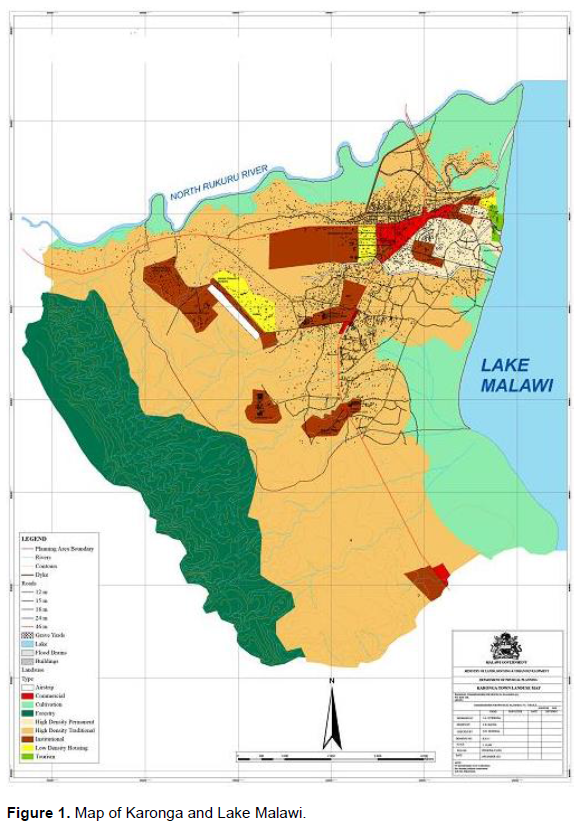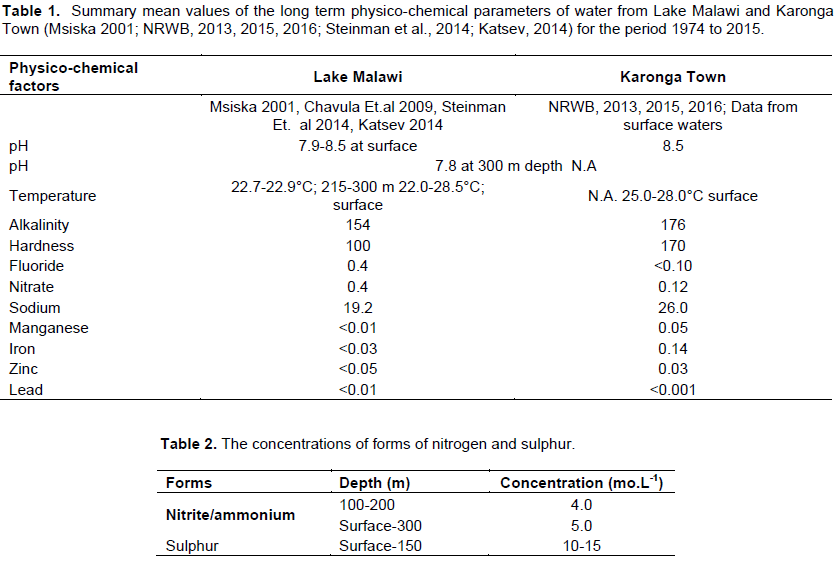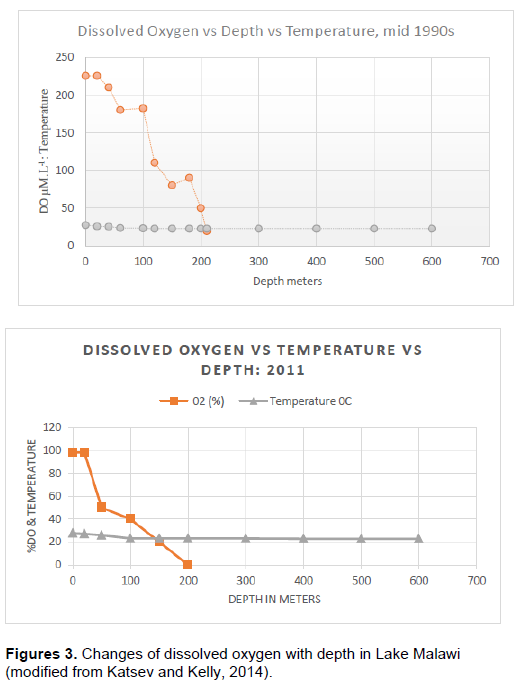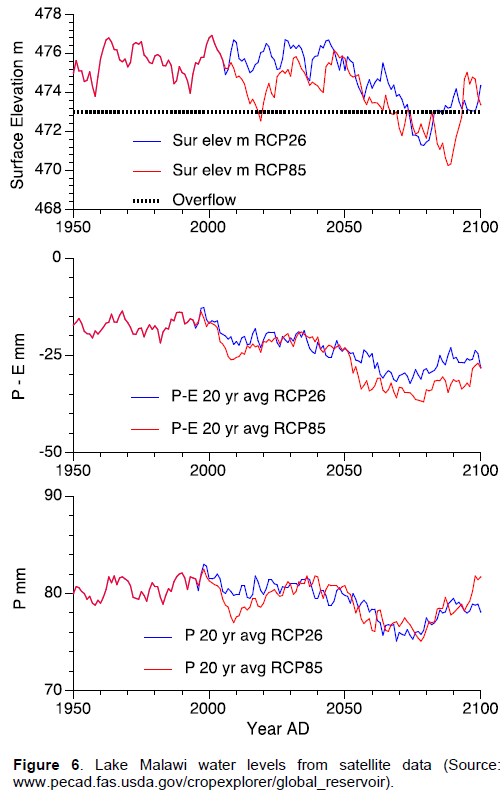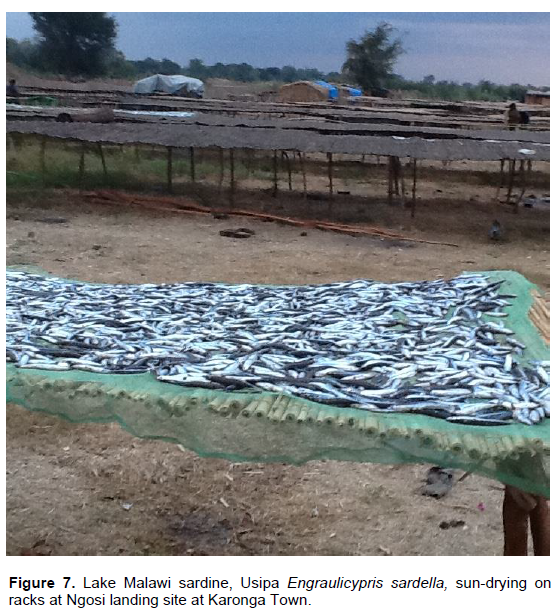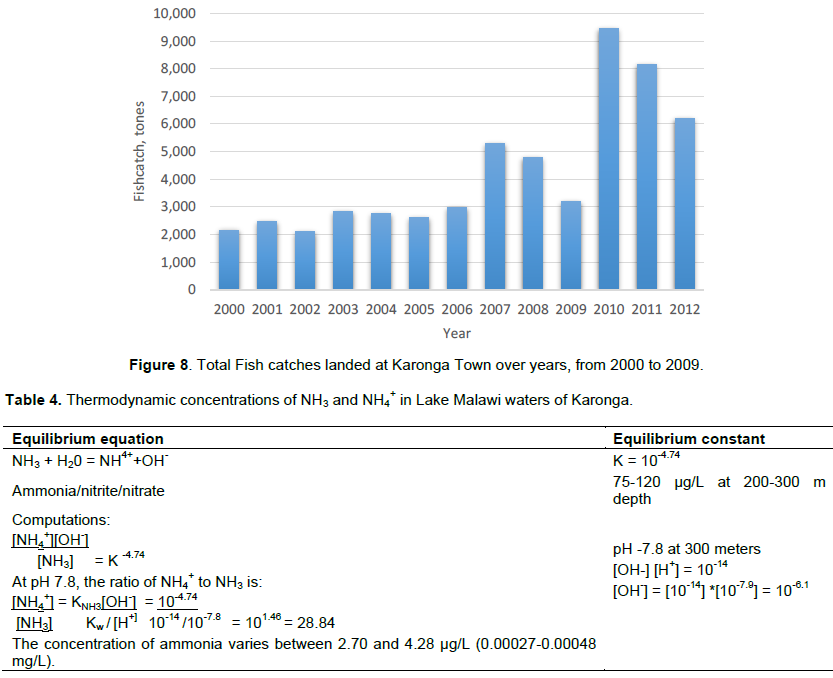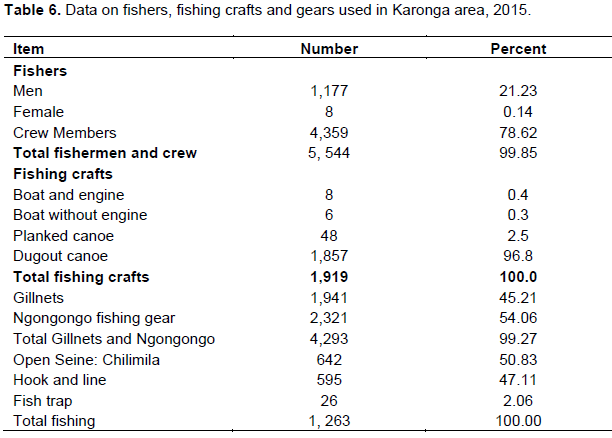ABSTRACT
There is evidence that ammonia, hydrogen sulphide and dissolved oxygen are implicated in fish kills occurring on the Lake Malawi shores of Karonga town. Exposure to fish is influenced by strong winds while water temperature differences cause upwelling and fish mortalities in surface waters. The vulnerability of fish in Karonga town to physico-chemical factors was computed from secondary sources data obtained in 2000 to 2016 regarding lethal and sub-lethal limits; this has helped to broaden our understanding of aquatic risk factors in this area. Equilibria relationships of ammonia (NH3 + H2O = NH4+ + OH-; K = 10-4.74; 2.70-4.28 µg.L-1 at depth of 100 to 200 m) and hydrogen sulphide (H2S = HS- + H+; K= 10-7.01; 54.9-82.5 mg.L-1 at a depth of 0-150 m) are imputed to have been implicated in the cause of a spate of fish kills. Uranium fallout might also be implicated but further analysis on actual exposure is needed to confirm this. Inferences of fish vulnerability have been drawn from studies done elsewhere on similar freshwater fish but under controlled conditions. While fish catches temporarily improved in 2007-2008 and 2010-2011, changes in fish diversity have been consistent, such as the disappearance of Ntchila (Labeo mesops), decline of Chambo (Oreochromis species) and the dominance of sardine type Usipa (Engraulicyprus sardella). Therefore, other sources of risks are over-fishing and climate change; the latter is evidenced by warming of the deep water columns, reduced dissolved oxygen and declining Lake Malawi water levels. The significance of fish by-catch recorded as ‘others’ indicates that a high number of fish species remain scientifically undescribed, hence the need for further taxonomic studies. Fish catches as per caput fish supply for Karonga District (19.5-38 kg) are above the current national average of 4.0 go 5.8 kg. Since fish provides Karonga communities with affordable animal protein, it significantly contributes to food security for the town. More than 5,500 people depend directly on fishing, representing 10% of the population of Karonga. Fisheries are a driver to rural commercialization for businesses of up to 22,000 people; hence, it is critical to people’s livelihoods and incomes at the local level. Therefore, this study confirms what has commonly been observed for Karaonga town; that fish as a nutrition and income source should be factored into studies dealing with risks to livelihoods of Karonga town communities; even where this might require indirect methods of assessment.
Key words: Fish catches, Karonga town, Lake Malawi, fish diversity, per caput fish supply, thermodynamic concentrations (H2S/HS-; NH3/NH4+).
Fish resources have been reported to be vulnerable to several human-induced and climate related risks (Hecky et al., 2006), while epizootics have also been implicated where environments have been compromised (Austin,2007). According to Randall et al. (2009), invasive/non-native plant species, wetland degradation, climate change, shoreline habitat modification, water withdrawal, land use around the lake, eutrophication, pollution, toxic algal blooms, fishing exploitation, illegal fishing are some of the greatest threats to fish populations.
Generally risk studies of wild fisheries have been undertaken after the occurrence of major local events like tsunami, or global events such as El Nino or La Nina, On the other hand, there has been little attention directed towards small but persistent changes in environmental conditions in inland water bodies, such as Lake Malawi (Government of Malawi, GoM, 2011). Dodman et al. (2009) have drawn attention to urban intensive and extensive risks such as strong winds, including those that go unnoticed at community level and occur in urban areas such as Karonga town. Specifically, the objectives of this study are firstly to determine the nature of causes of recurrent fish mortalities along the lake shore. Secondly to what extent do fish contribute to livelihoods in Karonga town? These objectives were investigated under risks and hazards affecting communities in Karonga town as part of the Urban Africa Risk Knowledge: breaking the cycle of risk accumulation (www.urbanark.org/city/karonga-mlawi).
Fish around Karonga town are exposed to a wide range of risks, some of which have resulted in dramatic events such as unexplained fish mortalities which occurred along the shoreline in 1999, 2005/2006, 2010/2011, August 2014 and December 2014 (Msukwa, 2015). There is an increasing frequency of this phenomenon in Lake Malawi generally and Karonga town is particularly prone and therefore warrants full investigation. Although fish mortality in Lake Malawi were studied by Rusuwa et al. (2015); their findings were inconclusive and did not isolate the cause. Risk related fish studies could assist in formulating ecosystem-wide management approaches or at least provide an understanding of the major threats.
Impacts on the fish resource usually occur from factors that directly affect biomass or through the cascading effect on the food chain. Thus, both extensive and intensive risks depend primarily on local physico-chemical factors as drivers of the ecosystem. In addition, one of the most documented risks is loss of diversity from alien or non-indigenous species introductions due to the aggressiveness, adaptability and high reproduction success of new organisms in new ecosystems as reported from examples from Africa and America (McRobert, 2011).
In Lake Victoria, fish species decline has been the most profound vertebrate loss in recent years, where, 400 Haplochromis species have been lost since the exotic predatory Nile Perch (Lates niloticus) and herbivorous Oreochromis niloticus were introduced in the 1950s (Gophen, 2015). This has heightened the importance of risk assessments in aquatic environments (Mills et al., 1993). Once the fish resource is in crisis, livelihoods get affected from unstable income for fishers, inadequate protein foods; and the social structure gets disturbed (Ruddle, 1991). It is said that although Lake Malawi has never faced the same crisis, introductions remain a real future threat from fish movements across the borders in the same catchment area (Genner et al., 2013). Meanwhile, it is important to understand the current risks without the confounding impacts from exotic species. In Malawi, fish contributes 60 to 70% to the animal protein consumed by the local population, however, since 1990, Lake Malawi has reported a decline of almost 93% in catches (www.irinews.org/report/100806/lake-malawidwindling-fish-stocks).
The Urban-Ark Research project provided an opportunity to understand the causes and effects of fish changes as they affect people’s livelihoods in Karonga town and to inform management of the town and thereby contribute to citizen science.
This study contributes to the broad theme concerning; “the nature, scale and distribution of risks across the whole spectrum of hazards in urban centers and their inter-linkages” (Urban-Ark; http://deve.urbanark.org.). Since the fisheries sector in Malawi is an important source of; (1) employment, (2) rural incomes, (3) food security, (4) import substitution, and (5) biodiversity, dedicates studies are warranted. For instance, in 2002, the contribution of fish to livelihoods was estimated at 9% in Karonga (FAO Country Fisheries Profile, Malawi: http://www.fao.org/fish old site/FCP/en/MW1).
Study site
This study was conducted at Karonga town during the period 2015 to 2016 and is believed to have had a population of around 50,000 in 2009, and is estimated to increase at 4.1% per annum (GoM, 2009). The town is bordered on the east by Lake Malawi (Figure 1); as a result, community livelihoods are highly influenced by the aquatic environment.
The mainstay of the economic life of people in Karonga district are agriculture (particularly rice, maize, cassava, cotton and groundnuts), livestock and fishing (GoM (Karonga SEP), 2016). Livestock farming is relatively high, particularly cattle (97, 214), goats (40,176), pigs (64,663), chicken (120,000) and guinea fowls (29, 148), however, their contribution to household nutrition has not been quantified.
Fish contributed at least 6, 000 tones in 2012. Figures are reported as lump sums and are not segregated into zones, however Karonga town is the hub of all types of trading including fish.
Physico-chemical risks
The physico-chemical data from around the lakeshore areas of Karonga have been obtained from secondary sources such as Msiska (2001), Msiska et al. (In press), Northern Region Water Board (2012, 2013, 2015), Katsev (2014) and Katesv and Kelly (2014). The methodologies for obtaining primary data and analysis adhered to standard methods outlined by APHA (2016) using calorimetric, titrimetric and spectrophotometric techniques and were therefore comparable to studies done elsewhere. Real time data for Lake Malawi water levels were downloaded from the USDA website (www. pecad.fas.usda.gov/cropexplorer/global reservoir).
Summaries were made of surface temperature, water levels, ammonia, sulphur forms, dissolved oxygen and sedimentation rates. More recent data on the above mentioned parameters has been obtained from Katsev (2014) (Steinman et al., 2014) as well as Katsev and Kelly (2014) who have devised new techniques of obtaining real time data using underwater equipment. In this study, the raw data were subjected to further computations using chemical thermodynamics equations for ammonia and sulphur employing the following equilibrium equations generally used in aquatic systems as proposed by Boyd (1982):
NH3 + H2O = NH4+ + OH- ; K= 10-4.74 (1)
H2S = HS- + H+; K= 10-7.01 (2)
The occurrence and quantities of chemical species were influenced by pH, thus, all computations were conducted relative to this parameter, and were applied to waters found in Karonga town. This allowed for various forms of elements to be quantified so that actual sources of toxicity are confirmed and documented.
Uranium waste/discharge from Kayelekela Mine
Karonga town is about 52 km away from a uranium mine at Kayelekela. Dr. Bruno Chareyron (French Nuclear Physicist, CRIIRAD: Commission de Recherche et d’Information Independantes sur la Radioactive) provided two reports about fallout from the mine, and inferences from that data with reference to fish were also used in this study. Dr. Chareyron measured concentrations arising from excavated uranium and those from mining effluents. The possible harmful effects on fish were made from inferences using studies from elsewhere; particularly those conducted by Bennett (2006) and Simon et al. (2011). At the time of this study, Malawi did not have the capacity to conduct fish toxicology studies.
Collection of fisheries and biological data
According to fisheries experts, Karonga has been divided into several strata comprising of 18 active landing sites, which are used for statistical surveys.
Frame surveys
Annually the Malawi Government Fisheries Department establishes the number of crafts and fishing gears used in all waters of Malawi. The water bodies are divided into strata to provide statistical zones that are clustered into specific sampling areas. Each landing beach is visited three times counting the gears and crafts and taking an average over three days.
Traditional fisheries data collection techniques
There is already a catch assessment system (GoM 2016) from which data was extracted for this study. The data were segregated according to beaches around the Karonga region. By analyzing time series fish catches for Karonga, the study was designed to demonstrate changes in quantities and fish types, and the trends were computed over a period of time. To validate the data, selected beaches were assessed by personal visitation to observe fish sampling and activities at the beaches including Kambwe and Ngosi beaches.
Fisheries catch assessment method, CASS
In this method each beach is visited once a month for 4 days to weight fish catches for all fishermen found on the day, and to count the fishing crafts and gears employed. During the first day, only crafts and gears are enumerated. The second, third and fourth days are devoted to weighing samples of fish catches as fishermen alight from their vessels.
Fish catch analysis
Fish catches were obtained by using conversion numbers reflecting average gears and types and scaled up for Karonga town. The data are routinely being logged into a computer by government enumerators, cleaned and analysed at Monkey Research Station.
Fish supply indicator
Fish supply per caput was used as one indicator of the role of fish the livelihoods of fishers in the absence of data on actual consumption. It was computed from human population data, where: Fish catch in kg/population = fish supply per caput per year
Population figures were obtained from the latest National Statistical figures (GoM, 2009, 2010).
The results of the mean values of various physico-chemical parameters for Lake Malawi and Karonga Town are presented in Table 1, while the results from the chemical computations are given in Tables 2 and 3. Selected factors such as sulphate/sulphide, dissolved oxygen, water temperature and water levels that have been undergoing significant changes with time and space and are shown in Figures 1 to 6.
The most notable features of the data are that chemical parameters change with depth such that oxidation reduction processes create unfavorable environments for fish. This is particular significant for sulphur and nitrogen forms. Since the depth of lake water is on the decline temperature changes are likely to confound the environment further.
Karonga has generally higher chemical values than the rest of the lake, notably alkalinity, hardness, sodium. Manganese and iron. However, they all fall within the range of most inland water lakes. The pH values are higher in surface than in deeper waters; being chemically an overall governing parameter, its implications are discussed subsequently in relation to sulphate and ammonia and in turn how fish might be affected.
The values of sulphur forms are considered (Figure 2) to provide an example. Sulphur forms and concentrations are strongly influenced by pH whose toxicity is further influenced by depth; this is particularly true of hydrogen sulphide. For every 6 molecules of HS-, there is 1 molecule of H2S. Table 3 shows that a lot of hydrogen sulphide forms will be in ionic state at pH 7.8; however, because of high sensitivity by fish, the values of the gaseous form in this water body are considered to be generally high and toxic to fish.
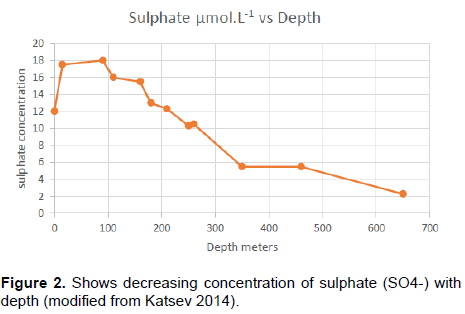
Ammonia forms are equally affected by depth and pH as shown in Figure 4. For 28 molecules of ammonium, there is 1 of ammonia gas. This implies that at pH 7.8 most of the ammonia will be in ionized form, hence not so toxic to fish.
A sharp decline occurs after a water depth of 200 m to less than 10 mo.L-1, suggesting that sulphate is converted to hydrogen sulphide as dissolved oxygen becomes scarce. According to results obtained at Karonga town, there are very low or undetectable concentrations of iron in the Lake Malawi water body. This is a significant finding as ordinarily iron forms precipitates with sulphate/sulphide, making them unavailable to the water column. Therefore, most sulphate/sulphide ions were in solution and their distribution is largely dependent on the equilibrium stoichemistry relationships outlined in equation 2.
According to Boyd (1982), the unionized forms of hydrogen sulphide are toxic to fish but its ionized forms are not appreciably toxic. It is appreciated that analytical techniques measure total sulphide; thus, other forms can be computed with respect to pH. The pH of Lake Malawi in Karonga is 8.5 at the surface and 7.8 at 300 m depth, showing that there is low concentration of hydrogen ions in the water columns (above the thermocline). According to computations given in this study, the dominant form of sulphide will be HS- at lower pH. The toxicity to fish can be inferred from such studies as those conducted on Bluegill, Lepomis macrochirus, which show that the 96-h LC50 for fry is 0.013 mg/L, and 0.048 mg/L for juveniles forms, respectively, at 20 to 22°C (Boyd, 1982). When chronically exposed for 826 days at 0.002 mg/l, adult bluegill did not deposit eggs. This implies that fish in Lake Malawi experience mortality as concentrations of hydrogen sulphide accumulate, and during the aftermath of heavy winds causing an overturn. The toxic form of ammonia is the un-ionized form while the ionized form is relatively non-toxic. Boyd (1982) has shown that 0.12 mg/l of NH3 caused reduced growth and caused gill damage to channel catfish (Ictalurus punctatus). Both un-ionized hydrogen sulphide and ammonia increase as the pH drops, thus it can be postulated that as pH in Lake
Malawi decreases these gases accumulate at greater depths. This is supported by observations of fish mortality made by Jackson et al. (1963), Eccles (1974), and Patterson and Kachinjika (1995). The ammonia conversion processes are mediated by microfauna, nitrosomonas and nitribacter bacteria, as the lake environment is composed of both oxygen and deoxygenated water columns as shown in Figures 3a and b. Figures 3a and b show that the depth at which low-dissolved oxygen has decreased over the years.
The progressive upward shift of waters with low dissolved oxygen over the years implies that the volume of deoxygenated water has increased. These conditions favour the occurrence of more reduced gases and hence more frequent fish kills.
Water temperature
Due to climate change, Lake Malawi water has experienced a rise in temperature, both in surface water and at greater depth as shown in Figures 4 and 5. That climate change forcing is affecting the behavior of Lake Malawi is evident from these figures, hence it might be further inferred that selective survival of fish is to be expected, depending on tolerance capabilities of each species. This is likely to be a major driver of the changes experienced in the diversity of fish species. Experimental studies on fish tolerances could confirm this and better inform the climate-change phenomenon in Lake Malawi.
Reducing lake levels have been evident for some time now, especially due to decreasing precipitation over the catchment area, as shown in Figure 6.
The general decline in water levels results in Lake Malawi experiencing reduced water volumes. This normally affects fish catches and diversity due to habitat changes (Tweddle and Magasa, 1989).
Possible uranium effects on fish
The uranium mining company has experienced a number of incidences that render monitoring crucial. For instance, storm water broke the liner to the plant runoff tank on 5th January 2015 when 25 mm rain fell on the site. Thus 500 m3 of material was releases over the banded area into nearby rivers.
A quantitative analysis of uranium fallout conducted by Dr. Bruno Chareyron, a Nuclear Physics Engineer of CRIIRAD and shared his report with the author. He analyzed air, soil and water samples from Sere, Champhanji, Champwasha and North Rukuru Rivers.
Water values ranged from 0.22 to 42.5 ug/l (0.003-65.38Bq/l) of Uranium 238. Champanji stream had higher concentration of 65Bq/l (5,230 ug/l) than Sere River from which it draws its water, implying that the latter has extra radiation of a natural resident origin. These rivers empty into North Rukuru which eventually ends into Lake Malawi.
The threshold for drinkable water as recommended by WHO is 30 ug/l, showing that water from streams and rivers adjoining Kayelekela Mining site should not be used for drinking.
From the air, Radon gas concentration ranged from <30 to 42 Bq/l. Because, there is an occurrence of other radionuclides such as Th234, Radium and Lead, it is suggested that more detailed studies are required in the area on radiation fallouts and impacts on the fauna and flora.
Bennett (2006) has shown that uranium affects Northern pike (Esox lucius), Burbot (Lota lota), and Spottail shiners (Notropis hudsonius) though the food web, directly affected were lipids and triglycerides which are useful endpoints. Simon et al. (2011) used fecundity, survival and reproductive success to determine endpoints in Danio rerio. The major conclusions from these studies were that several abnormalities occurred like failure of oocyte maturation and teratogenic effects were observed leading to failure of maturation processes. Uranium concentrations of 0.02 ug/l to 2 mg/L in natural waters were responsible for the aforementioned deformities and dietary route of uranium the chemical is said to play a critical route in its uptake.
Karonga river uranium contamination is well above threshold values reported to be harmful to fish, hence there is dire need to conduct toxicity studies on fish species around Karonga to further inform communities and authorities of the dangers posed by uranium to human and aquatic health.
Fisheries
There are always a lot of activities at fish landing sites attesting to the fact that fish is a source of affordable animal protein, income and employment. Figure 7 shows a typical activity at a beach in Karonga Town; sun-drying of Usipa occurs on all beaches.
Trends in fish catches
In Karonga District, the fish catch trend has shown an increase from 2,000 tons in 2000 to about 10, 000 tones in 2010 declining to 9,000 and less thereafter (Figure 8). These trends have implications for fish supply, people’s incomes, and supply and consumption levels. It was difficult to desegregate which catches belong to Karonga Town as fishermen’s movements are not confined to a particular area (Table 4).
However, these raw figures hide trends which require further analysis regarding trophic levels to show Eco trophic efficiencies reflected by species succession. It is notable that fish catches have been increasing and declines were observed after 2010, possibly reflecting national trends.
Fish supply per capita trends
The trends in fish supply per capita in Karonga Town have been presented in Table 5. The per capita fish supply for both Karonga district shows that the region is well supplied with fish as the per capita supply is well above the national average of around 4.0 kg of supply/capita (http://www.fao.org/fish old sites/FCP/enMW1Ma). Overfishing and climate change impacts seem to have indirectly affected catches.
It is generally believed that in Malawi up to 60 to 70% of national animal protein is derived from fish (FAO http://www.fao.org/fish old sites/FCP/en/MWI). The Malawi Poverty Reduction Strategy Paper: http://www.imf.org/external/np/prsp/2002/mwi/01/ shows that fish is one of the major drivers of the commercialization
of rural economies with a multiplier effect of 1:4 between point of production and consumption. Fish improves food marketing and rural incomes and Karonga town is an urban growth center in a rural setting, hence fish plays an important role in driving the rural economy.
Fish per capita consumption in Karonga town is more than 14 kg (or 200 to 500 mg of eicosapentaenoic and decosahexaenoicacids)that is recommended by WHO (www.who.int/nutrition/topics/5population_nutrients/en/print.html).
Changes in fish diversity in catch composition
Fish catches have been fluctuating over the past 20 years such that some species have become threatened and may appear sporadically in catches (Figure 10). Figure 9 shows such trends regarding Ntchila (Labeo mesops) and which has not appeared in catches in Karonga since 1996.

Similarly, scarcity has been experienced with respect to Chambo (Oreochromis Nyasalapia species) and Mcheni (Rhamphromis spp.). On the other hand, apart from catches of 2000/2001, Usipa (Engraulicypris sardella) has become more abundant. According to the most recent GoM Report (2016), from 2009 to 2012, Usipa has increased its contribution to the total catch to 75.8%, and is currently the most dominant species followed by Utaka (Copadichromis), Mlamba (Clarias gariepinus), Chisawasawa (Haplochromis), and Kampango (Bagrus merideonalis), respectively.
The succession trends displayed in these catches reflect the phenomenon of fishing down the food chain postulated by Pauly et al. (1998) for marine resources, where big and piscivorous fish are selectively removed leaving small and less valuable species.
On the other hand, the high oscillations shown by recent catches might be a reflection of biomass variation and are explained by Manda et al. (2016), as being driven by increases in temperature. Evidence points to the existence of a complex phenomenon involving dissolved oxygen, nutrient fluxes and density driven water mixing
for Lake Malawi.
Fisher folk dependent directly on fishing
Through frame surveys which are conducted annually, it was established that more than 5,500 people within Karonga are involved directly in the fishing activities around Karonga Town in the Table 6. The table shows that more than 10% of the population of Karonga is directly involved in fishing but only a small number are female, about only 0.14%. If the 1:4 multiplier effect is assumed, it means affecting 22,000 people in rural commercialization as a result of fish produced in and around Karonga town.
CONCLUSIONS AND RECOMMENDATIONS
The Urban-Ark Research Project has allowed this review to focus on risks factors which are normally ignored in many of the projects conducted in the region. Both incremental and cumulative risks were demonstrated through quantitative chemical analyses. While fish play a crucial role in the livelihoods of communities in Karonga, hazards that affect the resource have been given more focus than in previous studies. The study draws from other studies to establish a link between fish resource to everyday risks of both an extensive and intensive nature. In Karonga Town, the role of fish in livelihoods is shown by its high contribution to food security measured as per caput supply. Evidently, the fish resource serves the hinterland, thus there is likely to be a multiplier effect on livelihoods, the magnitude of which could be an area of future research. Similarly, there is lack of understanding on the underlying risks posed by processed fish products with respect to public health.
Fish kills have become a concern all over Lake Malawi whose frequency has increased over the recent years and Karonga town provides a good case study. There are many possible causes for their occurrence. While diseases may have been discounted because, generally, associated mortality tends to be chronic over an extended period unlike what has been the case in the current scenarios. Furthermore, other researchers have failed to isolate causative agents from resident fish, dead or alive. Therefore, the convergence of several phenomena is more plausible, as explained in this study, including:
1. Exposure to toxic reduced gases (hydrogen sulphide, ammonia, low dissolved oxygen),
2. Upwelling of toxins from dep stratified water layers due to strong winds,
3. Rising temperature in deeper waters, and
4. Uranium spillage into in rivers emptying into North Rukuru, and eventually ending in Lake Malawi.
Chemically, circumstantial evidence is gleaned from various sources of data collected from Karonga Town and adjoining waters. Water drawn from the surface and at 100 to 300 m depth of Lake Malawi shows that the gases ammonia, hydrogen sulphide and low dissolved oxygen are the main culprits; the toxic levels of the former two were shown to be thermodynamically mediated by the pH of Lake Malawi waters.
The dearth of information on uranium effects has been exasperated by the lack of independent monitoring to provide verifiable evidence on its effects on fish and other organisms.
As a result, there are many speculations advanced to link with fish kills. The current Urban African Risk Knowledge Project was used to highlight the real possibilities and could assist to bridge the knowledge gap between communities and authorities, as well as to un-earth cumulative risks.
It is further advocated that the contribution of fish to livelihoods needs to be captured in National Statistical Surveys for Karonga Town as it is a major dietary and commodity item. The study also shows that there are major gaps in environmental monitoring and local governance policy as it relates to urban centres. This study further demonstrates that Lake Malawi risks affect the link between fish and benefits arising from holistic ecosystem services studies; such information should as a matter of policy be shared at Karonga town District Administration meetings for proper planning and for communities to demand for appropriate services, as need arises.
The authors have not declared any conflict of interests.
REFERENCES
|
American Public Health Association APHA (2016) Standard Methods for the Examination of Water and Wastewater. 22nd Edition. American Public Health Association. Washington DC., USA.
|
|
|
|
Austin B (2007). The involvement of pollution with fish health. Multiple Stressors. A Challenge for the Future. Springer, the Netherlands.
Crossref
|
|
|
|
Bennett PM (2006). Effects of uranium mining and milling effluents of juvenile fish bioenergetics, growth and overwintering. MSc Thesis, University of Manitoba, Saskatchewan, Canada.
|
|
|
|
Boyd CE (1982) Water quality management for pond fish culture. Elsevier Press, Amsterdam.
|
|
|
|
Dodman D, Hardy J, Swatterthwaite D (2009). Urban Development and Intensive and Extensive Risk. In Global Assessment Report on Disaster Risk Reduction. United Nations International Strategy for Disaster Reduction Secretariat, 207p. GoM- Government of Malawi (2009). Population and Housing Census 2008 Main Report. National Statistical Office, Zomba, September 2010, 145p. GoM- Government of Malawi (2010). Population and Housing Census 2008: Analytical Report, Volume 2, Mortality. National Statistical Office, Zomba, August 2010, 51p. GoM- Government of Malawi (2011). The Second National Communication of the Republic of Malawi to the Conference of the Parties (COP) of the United Nations Framework Convention on Climate Change, UNFCC. Ministry of Natural Resources, Energy and Environment. Lilongwe, Malawi, 382p. GoM- Government of Malawi (2016). Karonga District Socio Economic Profile 2013-2018. Funded by GIZ and Deutsche Zusammentnartbeit.155p.
|
|
|
|
Genner MJ, Connell E, Shechonge A, Smith A, Swanstrom J, Mzighani S, Mwijange A, Ngatunga BP, Turner GF (2013). Nile tilapia invades the Lake Malawi catchment. Afr. J. Aquat. Sci. 38(1).
Crossref
|
|
|
|
Gophen M (2015) Ecological Devastation in Lake Victoria: Part B: Plankton and Fish Communities. Open J. Ecol. 5:315-325.
Crossref
|
|
|
|
Hecky, RE., HA Bootsma and E Odada (2006) African lake management initiatives: The global connection. Lakes and Reservoirs: Res. Manage. 11:203-213.
Crossref
|
|
|
|
Karonga SEP (2016). Karonga District Socio Economic Profile. Government of Malawi. 155p.
|
|
|
|
Katsev S (2014). Nutrients and Carbon in Lake Malawi. Presentation at Mzuzu University. Large Lake Observatory, Water Resources Science, University of Minnesota, Duluth.
|
|
|
|
Katsev S, S Kelly (2014). Changes in the Lake Malawi ecosystem. A Limnological Perspective. Presentation at Mzuzu University. Large Lake Observatory, Water Resources Science, University of Minnesota, Duluth.
|
|
|
|
Manda MAZ, Kamlomo D, Mphande C, Msiska OV, Kaunda J, Kushe J (2016). Karonga: Growth and Risk Profile, Urban Ark Working Paper, Number 9.
View
|
|
|
|
Mills EL, Leach JH, Carlton JT, Secor CL (1993). Exotic species in the Great Lakes: a history of biotic crises and anthropogenic introductions. J. Great Lakes Res. 19:1-54.
Crossref
|
|
|
|
Msiska OV (2001). A review of limnology of Malawi. In Wetzel, R.G. and Gopal (editors) Limnology in Developing Countries. Intern. Assoc. Limnol. 3:121-189.
|
|
|
|
Msiska OV, Manda MZ, Wanda E, Johnson C, Otuseye E. (In press). Vulnerability of the Water Purification Plant in Karonga Town. Urban-Ark Conference Proceedings. Forthcoming. Urban and Environment.
|
|
|
|
Msukwa Y (2015). Government probes extent of mass fish deaths on Lake Malawi in Karonga. Nyasa Times, January 9, 2015.
|
|
|
|
Patterson G, Kachinjika O (1995). Limnology and phytoplankton ecology. Chapter 1. In A Menz (Editor) The Fishery Potential and Productivity of the pelagic zone of Lake Malawi/Niassa. Natural Resources Institute. Chatham, UK.
|
|
|
|
Pauly D, Christensen V, Dalsgaard J, Froese R, Torres Jr. F (1998). Fishing Down Marine Food Webs. Science 279:5352:860-863.
Crossref
|
|
|
|
Randall RG, Koops MA, Munawar M, Minns CK (2009). Risk assessment of threats to large lakes around the world-a pilot survey. Verh. Internat. Verein. Limnol. J. Int. Soc. Limnol. 30(7):1030-1034.
|
|
|
|
Ruddle K (1991). The Transmission of Traditional Ecological Knowledge. Paper presented at the Panel on Traditional Ecological Knowledge, 2nd Annual Meeting of the Society for the Study of Common Property, 26-29 September, University of Manitoba, Winnipeg.
|
|
|
|
Rusuwa B, Mwastsetedza J, Changadeya W (2015). Mass fish kills in aquatic ecosystem: A review of the dynamics and their potential relevance to Lake Malawi. Malawi J. Agric. Nat. Resour. Dev. Stud. 1(1).
|
|
|
|
Simon O, Mottin E, Geffrey B, Hinton T (2011). Effects of dietary uranium on reproductive endpoints: fecundity, survival, reproductive success of the fish Danio rerio. Environ. Toxicol. Chem. 30(1):220-225.
Crossref
|
|
|
|
Steinman B, Brown E, Katsev S, Kelly S (2014). Future changes in Lake Malawi surface Elevation. Presentation, Mzuzu University. Large Lake Observatory, Water Resources Science, University of Minnesota, Duluth.
|
|
|
|
Tweddle D, Magasa JH (1989). Assessment of yield in multispecies cichlid fisheries of the southeast Arm of Lake Malawi. Afr. J. Cons. Int. Explor. Mer. 45(2):209-222.
|
